Want to make an all-natural laundry detergent as effective as commercial detergent? Your search is over. Here’s how to make the best DIY homemade laundry detergent. And all you need is 3 key ingredients and 15 minutes.
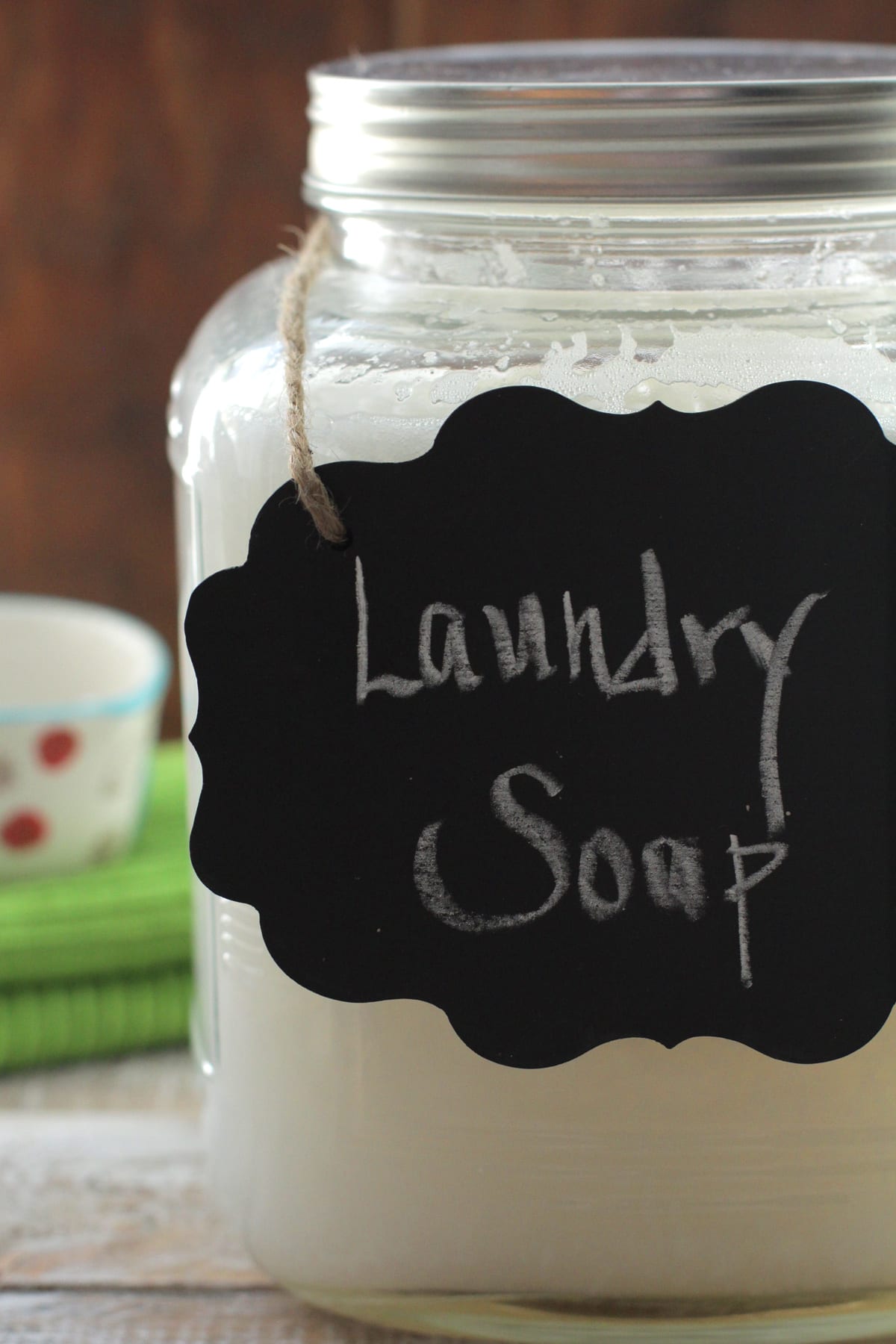
Want to Save This Article?
Enter your email & I’ll send it straight to your inbox. And you’ll get new recipes & tips each week.
11 years ago, I started making the switch to natural cleaning products, including laundry detergent!
At that time, the majority of recipes online called for a bar of fels naptha, washing soda, and Borax. But there was one problem: our clothes came out with chalky white spots.
So I made a simple swap: liquid Dr. Bronner’s castile soap instead of the fels naptha soap bar. With this one change, the detergent worked just as good as Tide.
This recipe is non-toxic, fights stains better than commercial detergent, and is cheap! I’ve been making this liquid laundry detergent for over 11 years (originally created in 2014) because of its extraordinary cleaning power.
Homemade Laundry Detergent Benefits
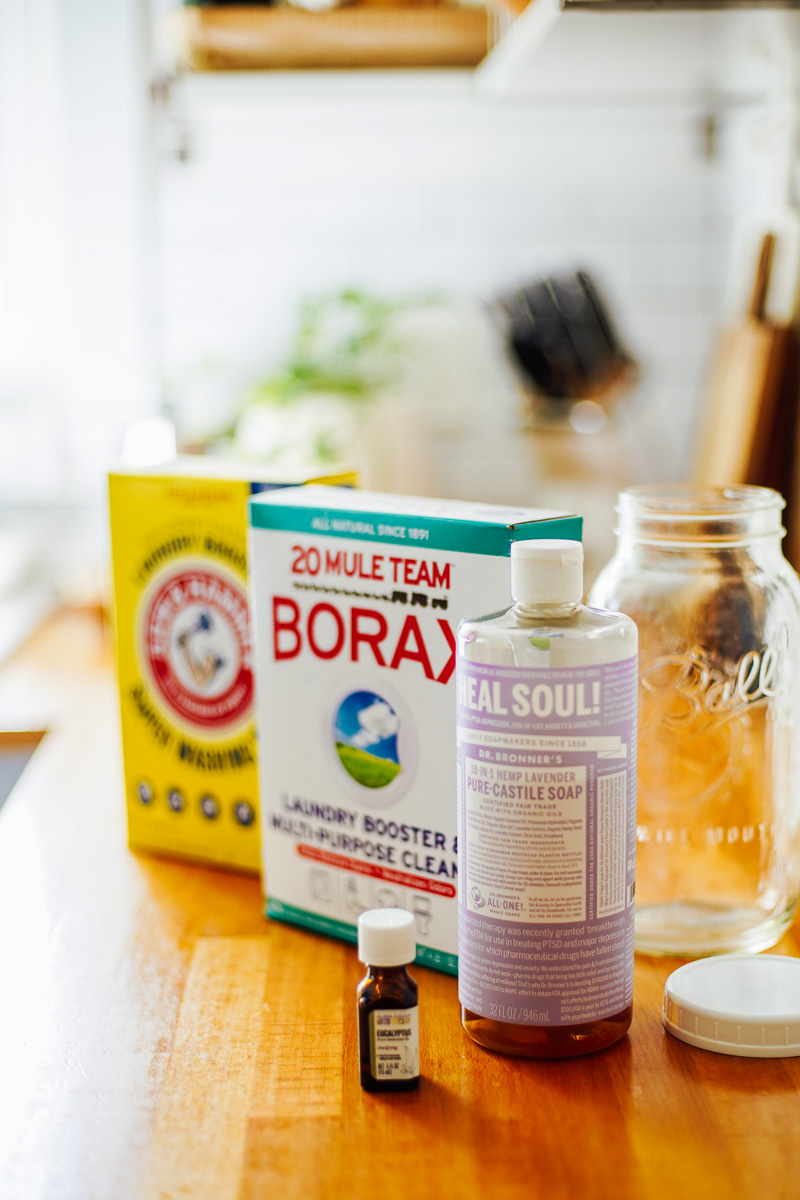
Before You Get Started: What You’ll Need
Ingredients
This recipe, made with simple ingredients, makes 1 gallon of homemade soap.
- 1 cup borax – freshens, deodorizes, and lifts dirt and stains
- 1 cup washing soda – freshens and deodorizes
- 1 cup liquid castile soap or Sal Suds – the main cleaning agent, lifts dirt and cleans
- 50 drops essential oil – optional for a scent
- 15 cups water – distilled water, found in any grocery store, is best as it doesn’t contain containments found in tap or filtered water
Equipment
- Large saucepan or Dutch oven – enough to hold 1 gallon of liquid, 15 cups
- Storage Jars – such as 2 half gallon-size glass mason jars, 1 gallon-size jar, or reuse an old detergent bottle
Thicker Detergent Tip: This recipe calls for 15 cups of water. If you’d like a thicker, more concentrated soap, use 10-12 cups of water.
How to Make Homemade Laundry Detergent: Recipe Steps
- Step 1 Boil 6 Cups of Water: In a large saucepan or Dutch oven, bring 6 cups of water to a slight boil. Once the water begins to boil, turn off the burner.
- Step 2 Add Borax, Washing Soda, More Water, and Castile Soap: Add the Borax and washing soda. Stir to dissolve. Then add 9 cups of room-temperature water and 1 cup of liquid castile soap. Give the ingredients a stir to combine.
- Step 3 Cool for 5-10 Minutes: Allow the soap to cool for a few minutes before pouring into one large gallon-size jar or smaller containers, like quart-size jars. Make sure your jar(s) are heat-safe. If not, wait until the soap is cool, then spoon the soap into the jar(s).
- Step 4 Add Essential Oil For Scent: Add an essential oil of choice (if using) to the soap (now in the jar) and stir to combine with the detergent.
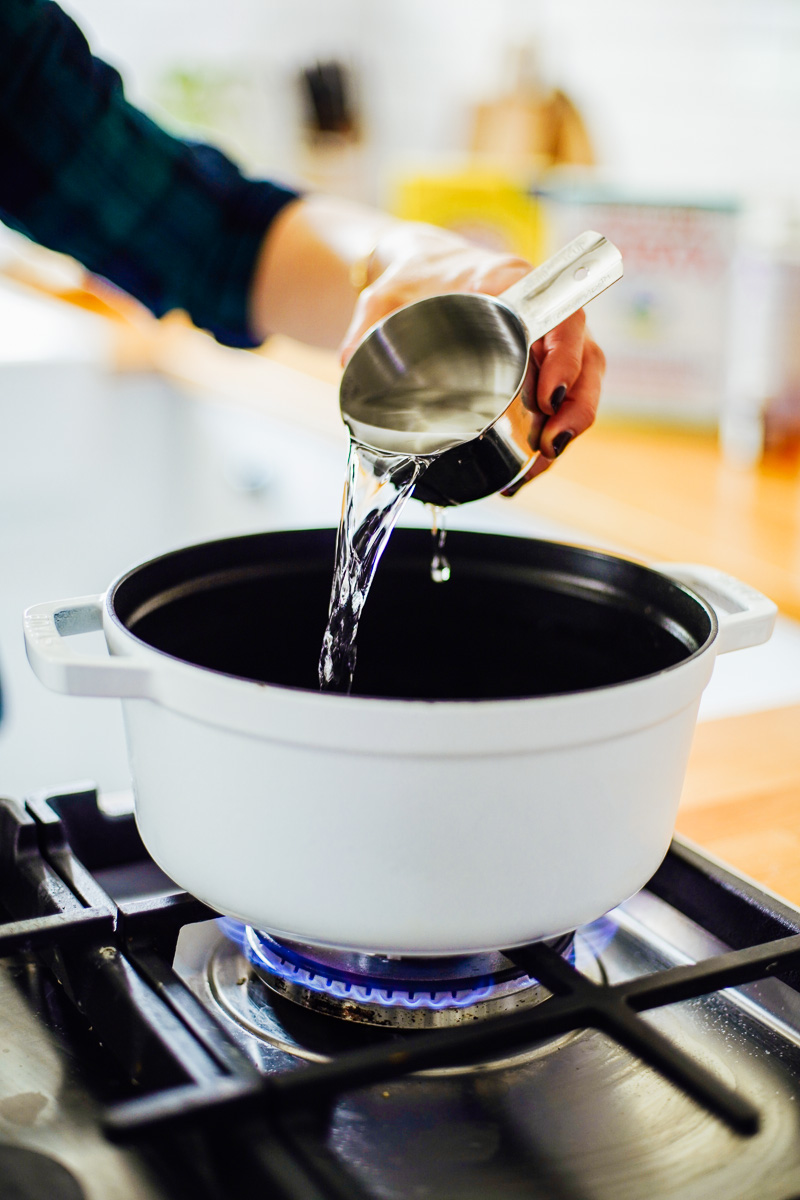
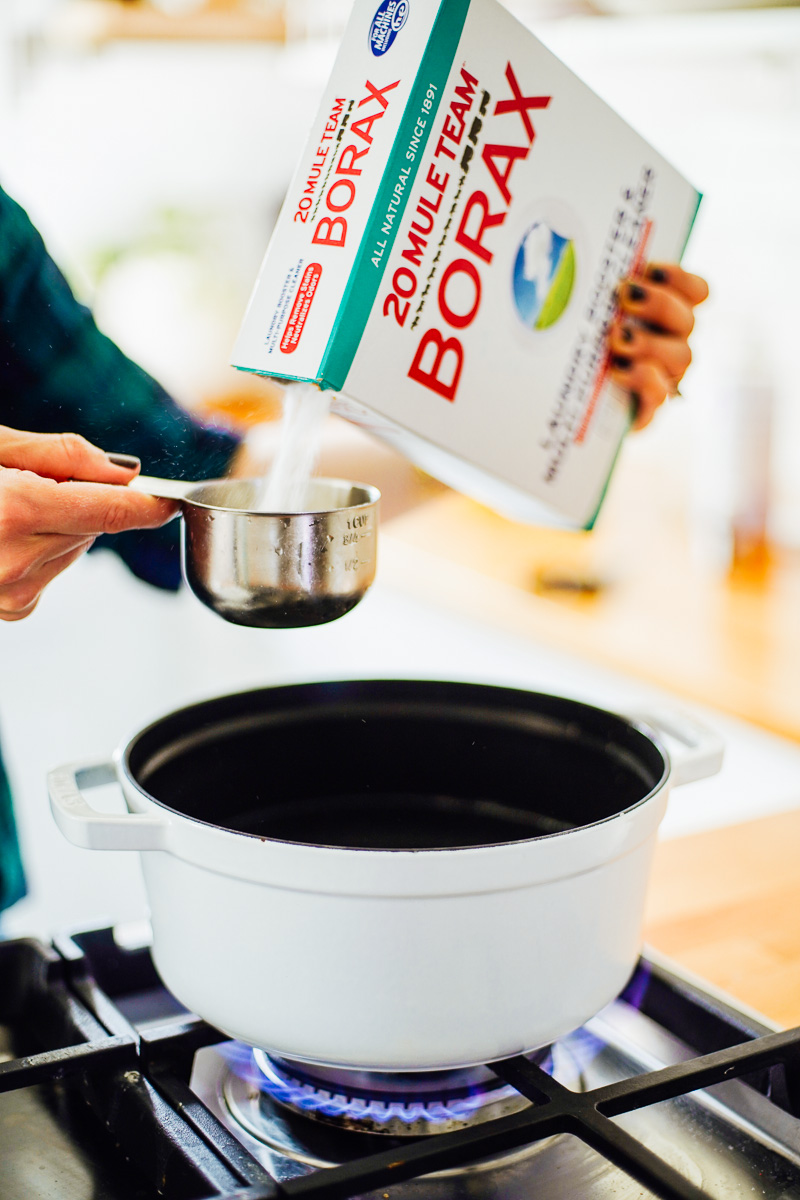
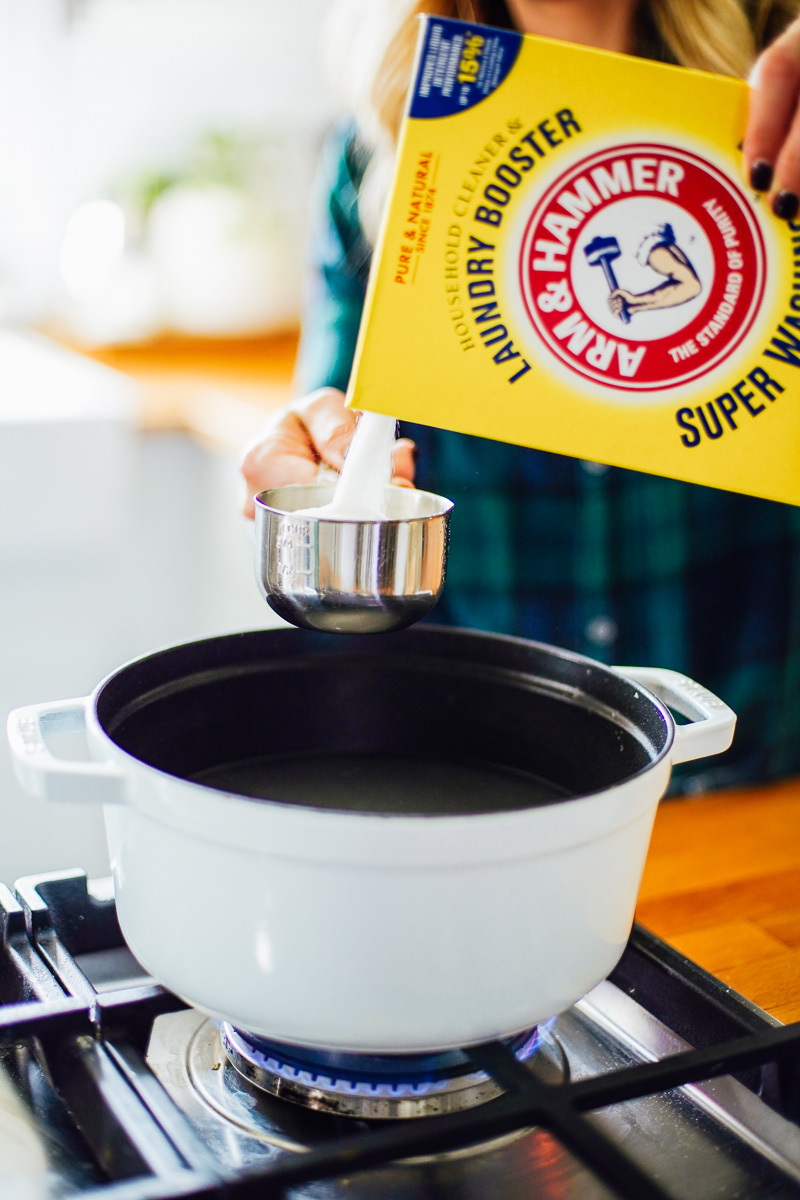
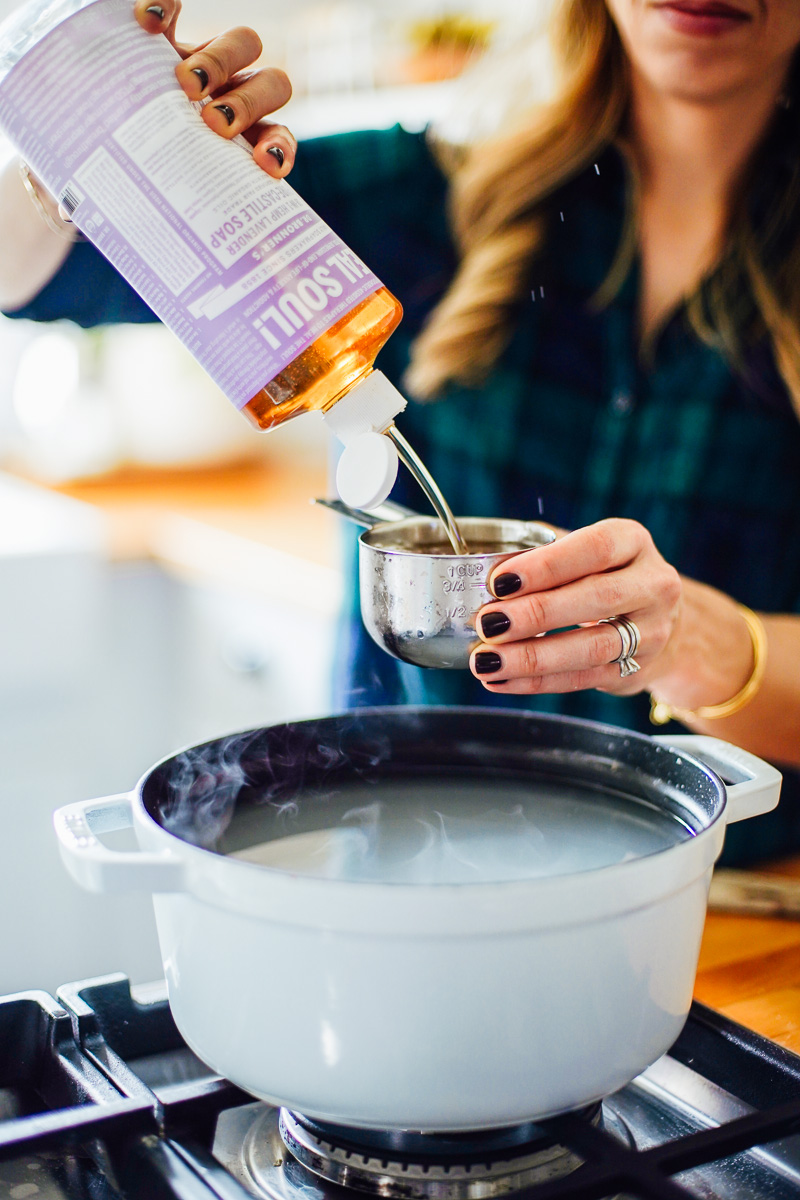
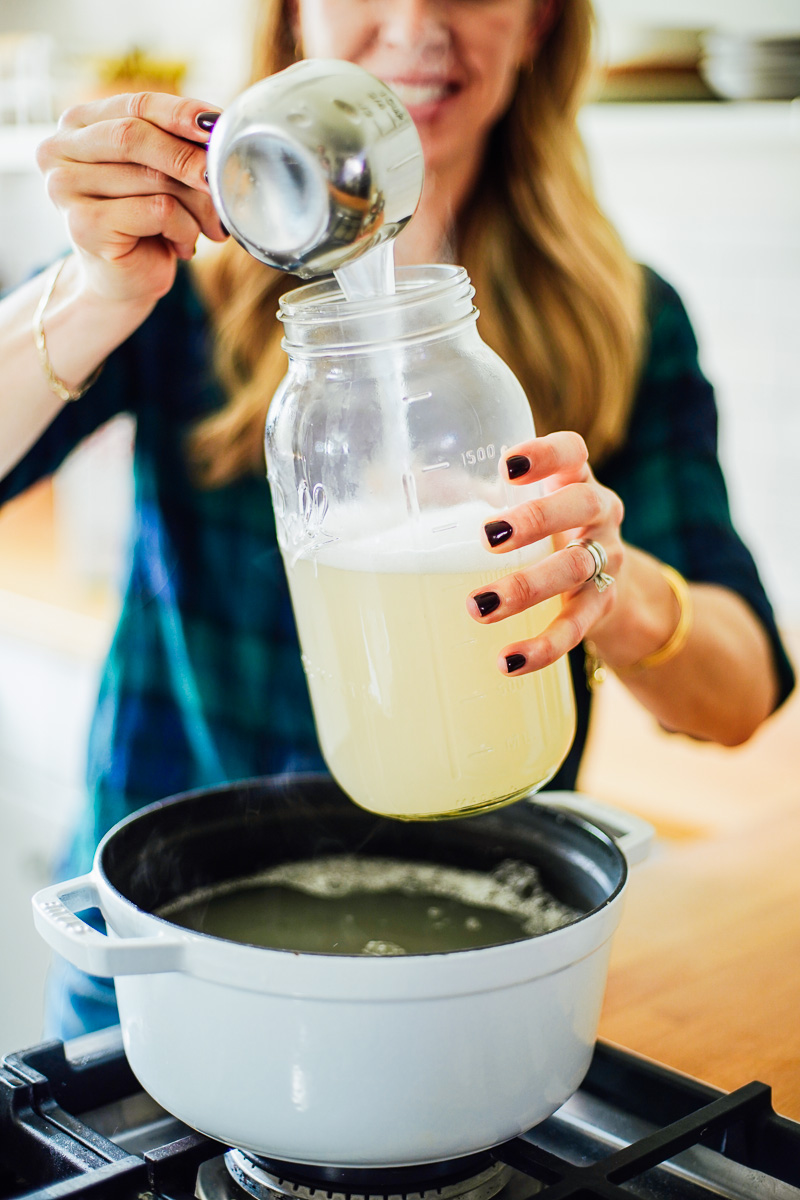
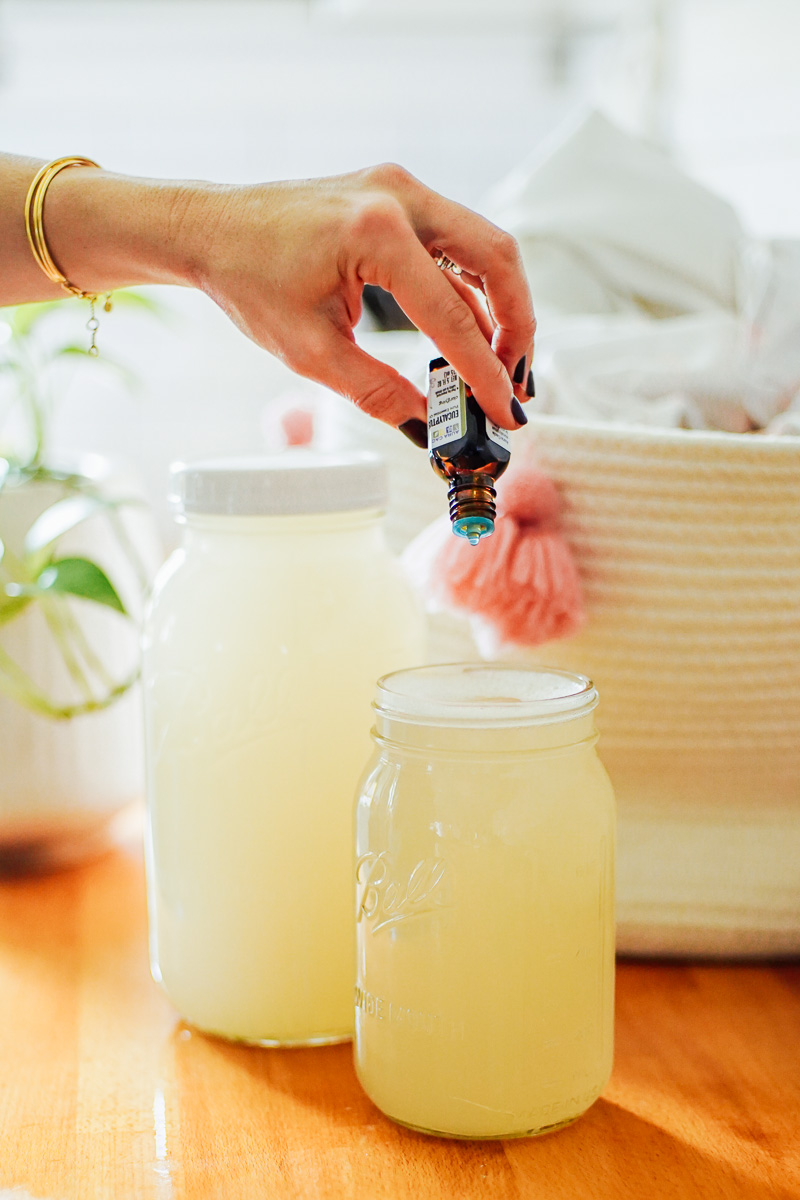
What to Avoid Doing
- Baking Soda – Don’t use baking soda in place of washing soda. Washing soda has a different chemical composition and will not work in this recipe. It is NOT a substitute.
- Dish Soap – Don’t use other dish soaps in place of the castile soap. Dish soap will cause the soap to have too many bubbles in the wash.
- Lack of Suds – Don’t assume that a lack of suds and bubbles means the soap isn’t effective. Suds and bubbles don’t equal clean.
- Plastic Containers – If you’re reusing an old detergent bottle for storage, make sure the laundry detergent is fully cool before adding to a plastic container.
- Heat-Safe Glass – Use a heat-resistant glass jar (if using glass for storage), and also allow the detergent to cool a bit (about 10 minutes) before adding it.
- Essential Oils – The essential oil will add a subtle fragrance, but shouldn’t be added until the soap cools as heat will cause the essential oil to evaporate.
How to Prevent Chunky or Gelled Detergent
After a few days the liquid laundry detergent may clump or gel. This is a completely normal chemical reaction that is usually caused when the outside temperature is cooler. There’s no way to completely prevent this from happening; however, one option is to use more water (2-3 cups more) to make a less concentrated soap.
The laundry soap is 100% usable if it gels up (l actually love this form). Simply scoop the detergent from the container and add to the washer.
Key Takeaway: Whether the laundry detergent gels up or remains liquid, it’s 100% effective and usable in both forms.
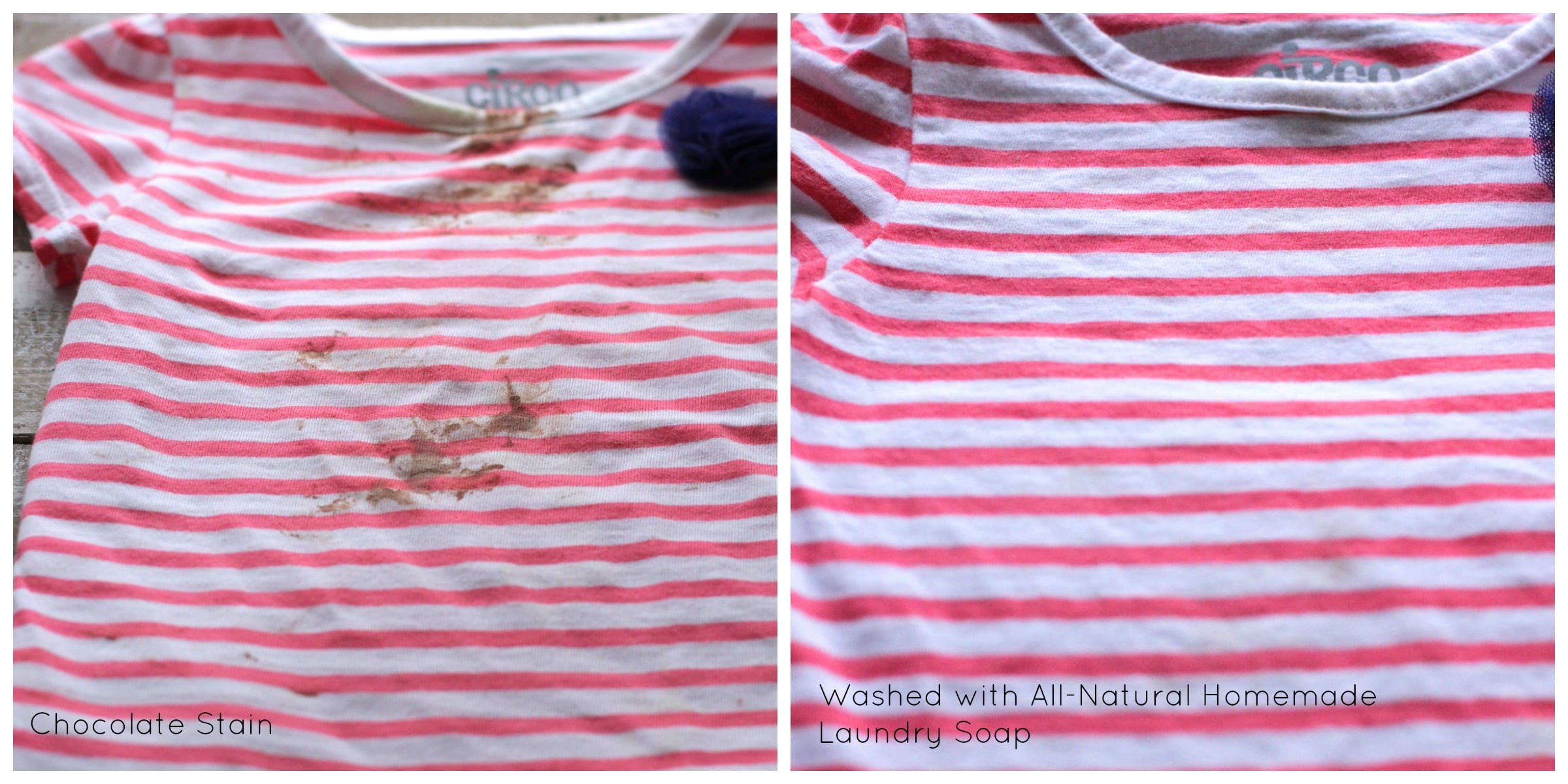
How to Use This Liquid Laundry Soap
The detergent is ready to use immediately after making. And may be stored for later use.
- Give the jar a good shake or stir (with a long spoon) before use.
- Use this detergent just as you would any laundry soap to clean clothes.
- This homemade liquid laundry soap is highly concentrated, which means you need only a tiny amount to get a dirty job done.
- For top-loading washer machines, use 1/8-1/4 cup.
- For an HE front loader, use 1-2 tablespoons.
- Add the detergent directly to your washer or the laundry soap compartment.
Can I use this in an HE washer?
I do, so I can only speak to my personal experience. I use 1-2 tablespoons per load. If it’s in gel form, add it straight to the washer on top of the clothes.
Always consult your machine’s user guide before using any laundry detergent to know what your machine can and can’t handle.
How long does this recipe last?
- Use the soap within 1 month.
- Store in your laundry room, at room temperature.
- Learn more about the safety of making your own natural cleaners.
FAQs
- Can I use a castile soap bar instead of liquid castile soap? Yes, you can. Use a cheese grater to grate a bar of castile soap into the hot water (along with the borax and washing soda). Stir and continue to boil the ingredients to dissolve fully (takes about 10 minutes). I also use a bar of castile soap to make powder laundry soap.
- Is it normal that it’s more watery than soapy? Yes, this is normal. For a thicker, more concentrated detergent, there are two options: use Sal Suds instead of castile soap OR reduce the water to 10-12 cups for a more concentrated detergent.
- The detergent is chunky (or gelled) after cooling, is that normal? Yes, this is normal. Depending on your home’s temperature, the soap may be more liquid or even chunky (like a gel). Both are normal and usable!
- My laundry soap didn’t gel. What happened? If your environment is cooler, your laundry soap may gel after cooling. Or it may not. This is normal. Both forms are 100% good and usable. A reader recently shared this tip you can try as well, “I also like the the detergent to be more gelatinous and I use my immersion blender for a few seconds after it is cool to whip it. It turns white and jelly.”
- Is borax safe? Borax is a debated ingredient in naturally-minded circles. I personally don’t see any reason to avoid it. This borax article from Wellness Mama has fantastic information.
- Can I use this soap to lift stains? Yes, you can. You can either add the garment to the washer or add the garment to your kitchen sink with the soap and water and soak the garment to lift the stains. Or, apply the soap directly to the stain and scrub. If you’re dealing with tough stain, I recommend using this homemade stain remover before washing the garment.
- Does this soap work with hard water? Yes, it does. I have hard water and this soap works great. You may want to use this laundry softener recipe as well.
Conclusion: Does this detergent work?
People always ask me, “Will homemade soap work as well as a store-bought product?” The answer, “YES! It will.”
My daughter’s chocolate stain on the left and after using this detergent in the wash. The stain lifted and the shirt was saved. If you need need extra help lifting a stain, you can also use my homemade stain remover first.
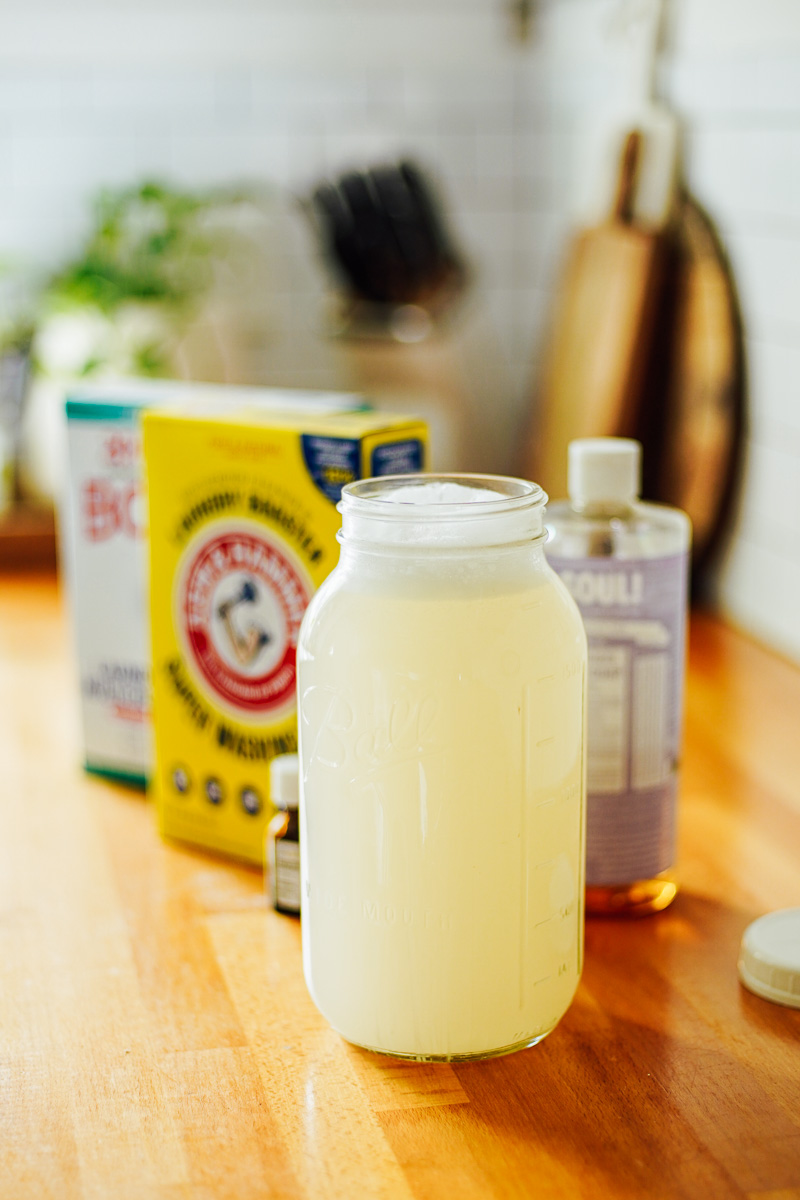

The Best Natural Laundry Detergent Brands: I’ve researched and tried many different laundry soap brands and narrowed down the best 11 brands!
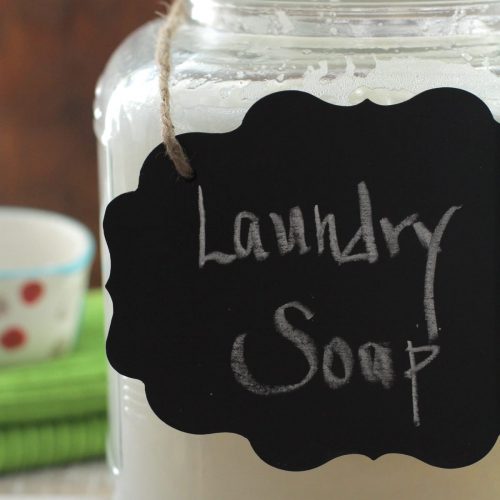
Homemade Liquid Laundry Detergent Recipe
Equipment
- 1 large saucepan or dutch oven (big enough to hold 15 cups of liquid)
- storage jars (such as 2 half gallon-size glass mason jars, 1 gallon-size jar, or reuse an old detergent bottle) for storing the laundry soap
Ingredients
- 1 cup borax
- 1 cup washing soda
- 1 cup liquid castile soap unscented or scented
- 15 cups water divided
- 50 drops essential oil optional for scent
Instructions
- In a large saucepan or Dutch oven, bring 6 cups of water to a slight boil. Once the water begins to boil, turn off the burner.
- Add the Borax and washing soda. Stir to dissolve. Then add 9 cups of room-temperature water and 1 cup of liquid castile soap. Give the ingredients a stir to combine.
- Allow the soap to cool for a few minutes before pouring into one large gallon-size jar or smaller containers, like quart-size jars. Make sure your jar(s) are heat-safe. If not, wait until the soap is cool, then spoon the soap into the jar(s).If you're reusing an old detergent bottle, make sure the soap is fully cool before adding to a plastic container.
- Add an essential oil of choice (if using) to the soap (now in the jar) and stir to combine with the detergent. The essential oil will add a subtle fragrance, but shouldn't be added until the soap cools as heat will cause the essential oil to evaporate.
- As the soap sits, the mixture may form into a gel and become chunky. There may also be liquid and gel separation, simply stir or shake. This is normal.
How to Use
- For top loading washer machines, use 1/8-1/4 cup. For a front loader, use 1-2 tablespoons. Add the detergent to the liquid soap compartment of the washer.
- Stain Treatment – Use a small amount of soap directly on the stain, scrub or rub the stain with a cloth. Repeat as needed, then wash the garment. Or use this stain remover spray.
- Laundry Softener – This laundry detergent may be used with a fabric softener. I use vinegar added to the softener compartment or this salt scent booster & softener added directly to the wash basin before running a wash cycle.


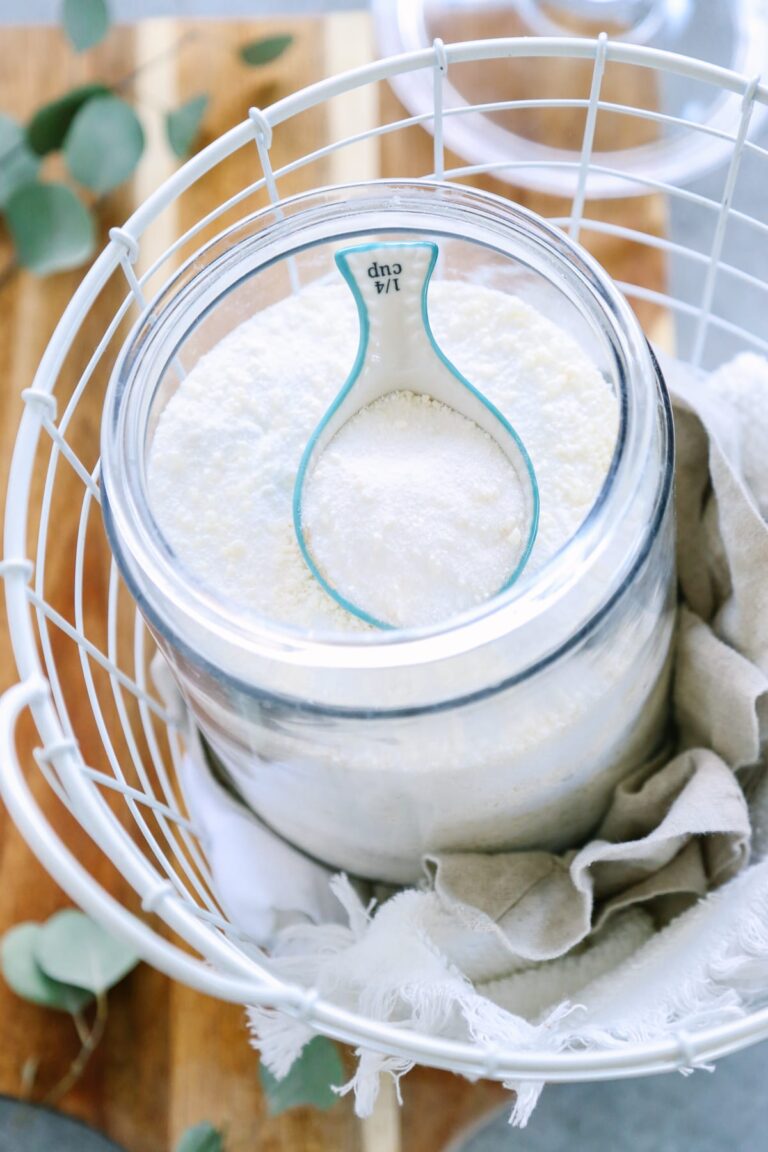
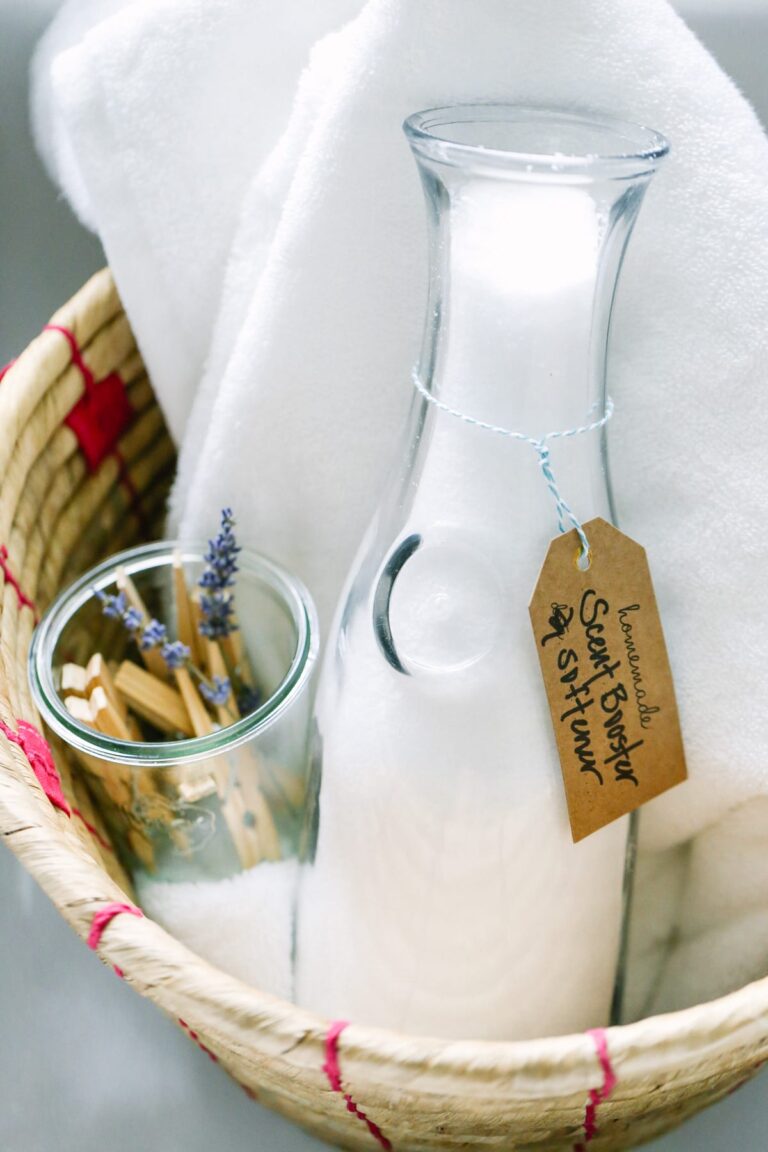
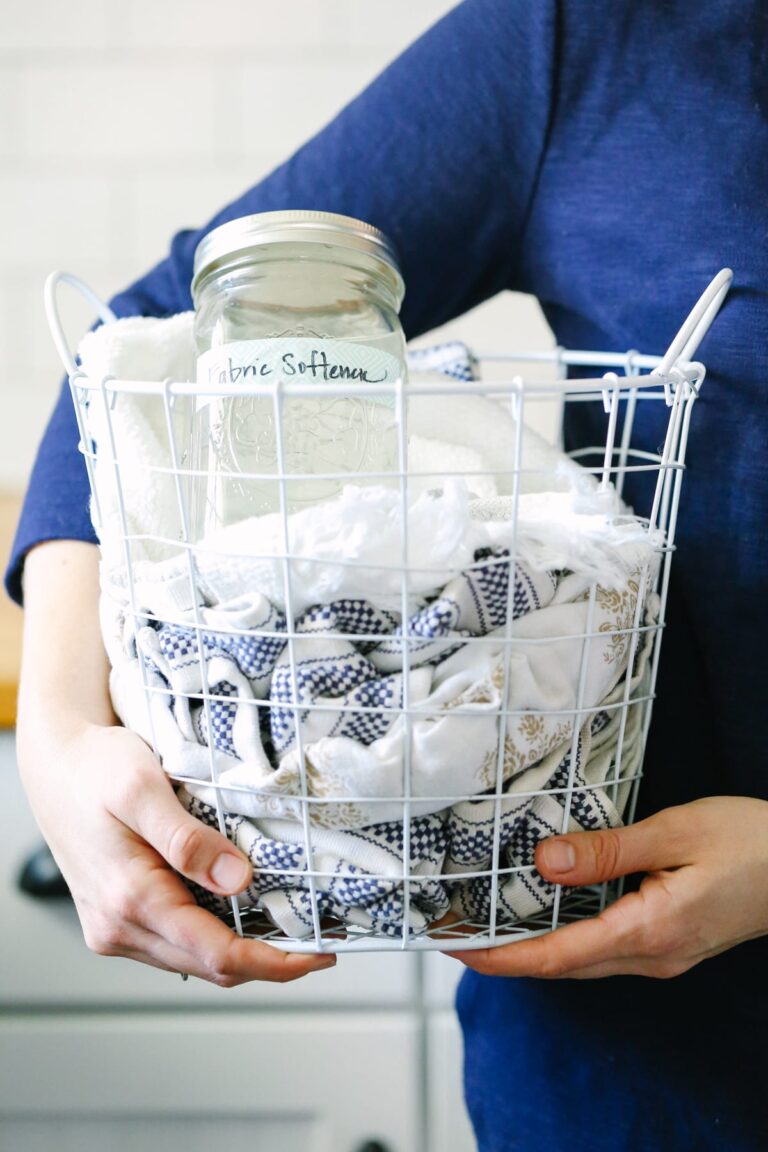
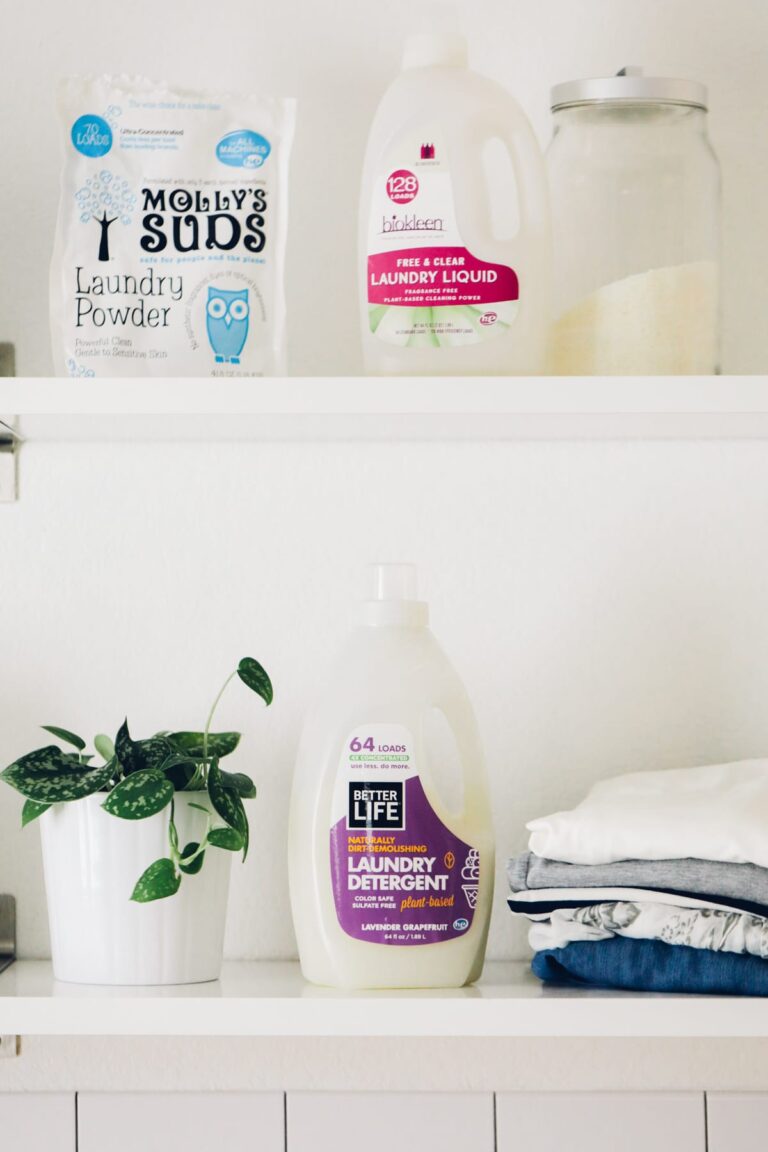
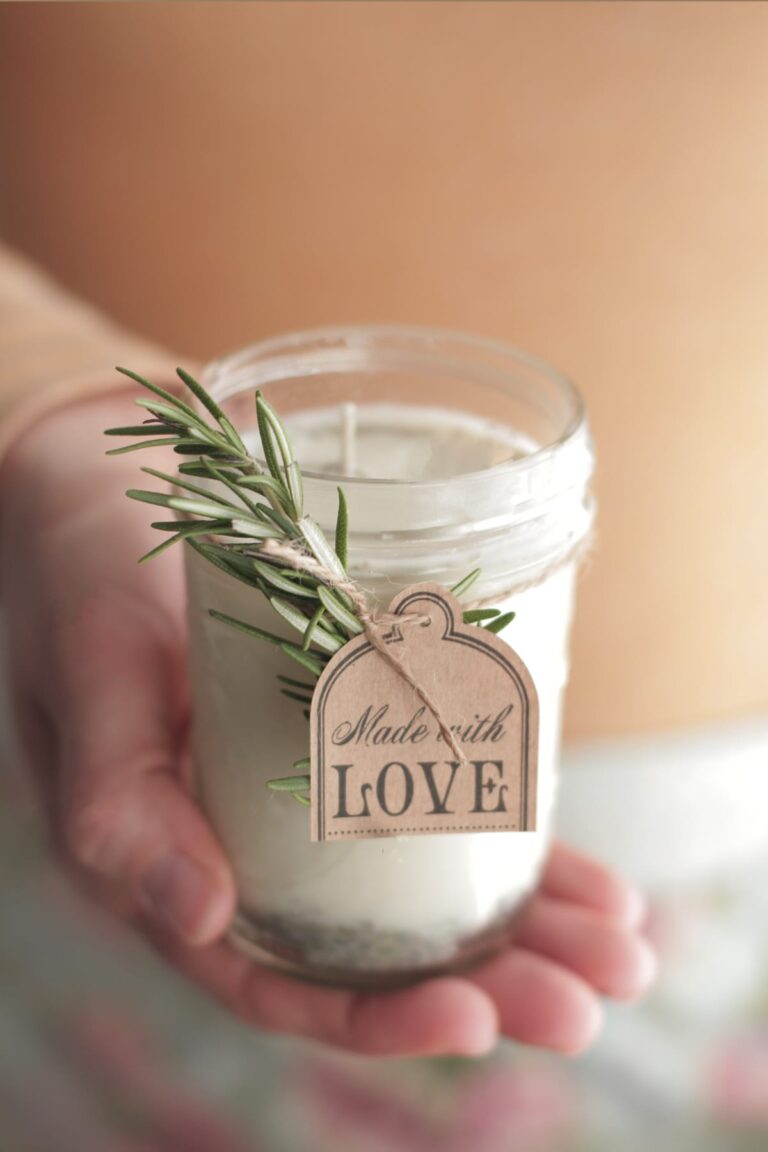
Hey! Loving your recipe for diy laundry detergent 😊 How many loads for this recipe?
Hey Lori, This will make about 16 cups or 57 loads.
Hi, I made this last weekend but only used 1/2 cup amounts to try it out with about 8 cups of water. Lots of clumps. I didn’t see it in your post, but does it matter what temp you wash the clothes on? I washed bamboo sheets on cold and the soap chunks didn’t dissolve. Ran it thru a few rinse cycles and it seems to clear. After drying, sheets look great, but it does feel like there is a film on them. Any tips on where I went wrong? Thank you!
Hey Autumn, You can use cold or hot water. But if it’s a thicker gel, you may need to cut the soap with water before use depending on your machine and if it will dispense gel. Some machines will mix water with a powder/gel soap automatically, some don’t.
Hi! I am trying out this recipe for the first time. I haven’t used the detergent yet, but I have a question regarding the measurements of detergent per load. I have a HE top loading washing machine, should I use the 1/8-1/4 cup measurement or 1-2 tablespoon measurement?
Thanks!
Hey Haley, 2 tablespoons is a 1/8 cup. It will depend on your machine. I recommend starting with 1/8 cup (2 tablespoons) and going up to 1/4 cup if needed.
Want to try my own laundry detergent but I have an allergic reaction to baking soda. What can I substitute for it?
Thanks
Hey Tricia, Will you have a reaction to washing soda like baking soda? If so, you can try using extra borax instead of the washing soda.
I’m having issues with my homemade laundry detergent. It gelled up but will now not go through the soap dispenser when it’s time. Any suggestions?
Hey Brandi, Depending on the washer, you may need to add it directly to the washer with the clothes. Some soap dispensers only work well with liquid soaps (a gel will be hard for the compartment to flush out). If you have a powder compartment, you could try adding it there as well since this compartment is usually mixed with water to flush it out when dispensing.
It great! My husband works construction and his clothes get very smelly. We both think his clothes smell better after washing with this recipe than the store bought product. I also like the the detergent to be more gelatinous and I use my immersion blender for a few seconds after it is cool to whip it. It turns white and jelly.
Love it, Ashley! That’s so awesome. Great tip with the immersion blender-thank you for sharing.
Hi, i made your liquid laundry detergent. I got crystals made in it the next day. They are settled at the bottom of my container. Is it okay? Should i somehow mix it again?
Hey Siddra, Yes, that sounds normal (hard to say without seeing a photo, so you’re welcome to email a photo to [email protected]). It’s good to use.
Hello, does this soap get moldy when it goes bad? If so, what does that look like? My jar has white flecks all over the walls and clumps of them suspended in the soap.
Hey Stephen, That doesn’t sound like mold, but just what the soap looks like after cooling and sitting. Sounds normal, but without me seeing it, use your best judgement. How long as the soap been sittng? Did you use distilled water?
My laundry soap did not turn white or “gel up” did I do something wrong?
Hey Karen, No, you didn’t. Sometimes it will gel, sometimes it may not. This all depends on the temperature it’s stored in. It’s perfect to use whether it gels or not. As noted in the post, the gelling is just a reaction that can occur, not an indication if that soap is effective or not.
Sounds like a great recipe! However I have seen comments online about these kind of ingredients voiding the machine warranty. ..?..? What do you think?
Hey Tess, Can you share more about this and the references to this? I’d love to learn more. As with any soap, always do your research and make the best choice based on that research. Never use something that directly violates your company’s usage (many appliances recommend particular brands). This is a personal blog, so I share recipes I’ve personally enjoyed and used.
Hi. I love the detergent! After about a week, the soap solidified in the mason jar. Is it still usable? How can I prevent this next time?
Hey Bridget, So glad you like it! This is totally normal and not something you can prevent-it’s just a reaction to the outside temp and the ingredients. It’s still very usable. You could try diluting it more with water when you make it next time and see if that helps.
Can I use this in an HE washer?
Hey Laurie, Yes, I do.
Hey! I have been trying this recipe, but it keeps “gelling” and becoming chunky. Has that happened to yours? Any suggestions?
Hey Amanda, Yes, this is very normal. I discuss this in the post, as many people experience this. Just scoop the gelled laundry detergent and add to the washer.
How long does this soap last, meaning does it ever go bad? Thank you
Hey Sonya, If using distilled water, I keep my soap for about a month. The main concern with water-based products is bacterial growth, so at some point yes the soap will go bad. That’s one of the reasons I recommend using distilled water.